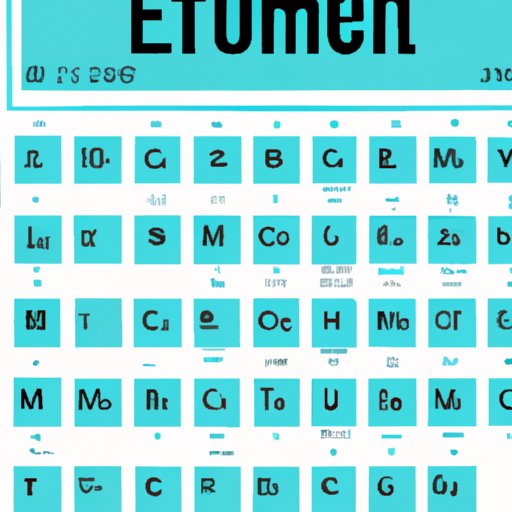Introduction
Elements are the building blocks of science. They are the components that make up all matter on Earth and form the basis for understanding many scientific concepts. This article will help readers understand what elements are, how they work, and how they can be used to solve problems related to them.

Exploring the Elements: A Comprehensive Guide to the Building Blocks of Science
An element can be defined as a substance made up of only one type of atom. All matter on Earth is composed of elements, which can be divided into two general categories: metals and nonmetals. Metals are typically solid at room temperature, while nonmetals are usually gaseous. Each element has its own unique properties, such as its boiling point, melting point, and chemical reactivity. These properties determine how elements interact with each other and with other substances.
Elements have a variety of common uses. In everyday life, we use elements for everything from the production of energy to the manufacture of electronics. Elements are also essential for medical treatments, such as cancer therapies. Elements are also used to create new materials, such as alloys, which are combinations of two or more elements.
The Periodic Table of Elements: An Overview of Chemistry’s Core Components
The periodic table of elements is a chart that organizes the known elements according to their atomic number, which is the number of protons in an atom’s nucleus. It was first created by Russian chemist Dmitri Mendeleev in 1869 and is still used today to organize elements. The periodic table is divided into seven horizontal rows, or periods, and eighteen vertical columns, or groups. Each element is represented by its own symbol, which consists of one or two letters.
The periodic table helps scientists better understand the properties of elements and how they interact with each other. By looking at the position of an element in the periodic table, scientists can quickly identify its atomic number, group number, and other characteristics. This makes it easier for researchers to identify elements and conduct experiments involving them.

Understanding Elements: A Primer for Science Students
Atoms are the smallest units of matter, and they are composed of three different particles: protons, neutrons, and electrons. Protons and neutrons are found in the nucleus, while electrons orbit around the nucleus. The number of protons in an atom determines its atomic number, which is the same as the element’s position in the periodic table.
Chemical properties refer to how elements interact with other elements or substances. For example, some elements are reactive, meaning they will readily combine with other elements to form compounds. Other elements are less reactive and do not easily form compounds. Physical properties, on the other hand, refer to an element’s physical characteristics, such as its color, density, and boiling point.
The Science Behind the Elements: How Do They Come Together?
Atoms combine to form molecules through a process called chemical bonding. This occurs when two atoms share electrons, either by transferring them from one atom to the other or by sharing them between both atoms. Chemical bonds can be covalent, ionic, or metallic, depending on the type of atoms involved and the number of electrons shared.
Chemical reactions occur when molecules interact with each other. During a reaction, atoms rearrange themselves to form new molecules. Reactions often involve the breaking and forming of covalent bonds, as well as the transfer of electrons between molecules.
Compounds are substances made up of two or more different elements. Compounds can be either organic or inorganic, depending on the type of elements present. Organic compounds contain carbon, while inorganic compounds do not.
From Atoms to Elements: A Look at the Science of Matter
Atoms are the basic building blocks of matter. They are composed of protons, neutrons, and electrons, and their structure determines the element they belong to. When two or more atoms come together, they form molecules, which are the smallest particles of matter. Molecules can then combine to form compounds, which are the building blocks of all matter.
Atoms form elements by combining in specific ways. For example, two hydrogen atoms can combine to form the element hydrogen, while two oxygen atoms can combine to form the element oxygen. Different combinations of atoms form different elements, and these elements can then combine to form compounds.
Conclusion
In conclusion, elements are the building blocks of science. They are composed of atoms, which are the smallest units of matter. Elements have unique properties that determine how they interact with each other and with other substances. The periodic table of elements is a useful tool for understanding and organizing elements. Finally, atoms combine to form elements, which can then combine to form compounds.
This article has provided an overview of elements and how they work. For more information, please refer to the resources listed below.
Further Resources:
Elements are the fundamental building blocks of science, and understanding them can help us better understand our world. With this knowledge, we can create new materials, discover new treatments, and find solutions to complex problems.
(Note: Is this article not meeting your expectations? Do you have knowledge or insights to share? Unlock new opportunities and expand your reach by joining our authors team. Click Registration to join us and share your expertise with our readers.)
